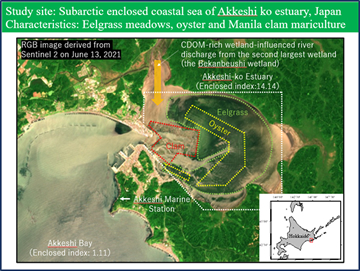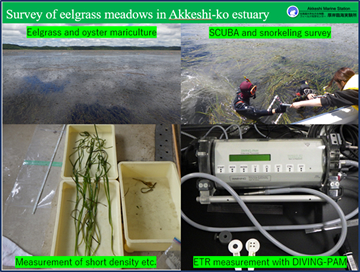FY2022 Grants-in-Aid for young researchers
POSTED:Aug 24, 2022
This is the third year since we started this program, and thanks to your support, we have received 13 applications.
On Thursday, June 30, a rigorous selection process was conducted at the EMECS researchers’ meeting, and seven researchers were selected as grant recipients, including four who continued their research from last year.
| Title | Name | |
|---|---|---|
| Integrated research for the recovery of short-necked clam, Ruditapes philippinarum, resources in the sandy tidal flats facing the Ariake Bay, Japanmore… | Tomohiro Komorita | Department of Environmental & Symbiotic Sciences Faculty of Environmental & Symbiotic Sciences Prefectural University of Kumamoto |
| Analysis of the positive and negative effects of measures to increase nutrient loads on coastal, offshore, and adjacent seasmore… | Yusuke Nakatani | Department of Civil Engineering Graduate School of Engineering Osaka University |
| Historical changes of the supply of silica in the coastal areas and its effects on community structure in tidal flat ecosystems(Second year)more… |
Megumu Fujibayashi | Department of Urban and Environmental Engineering Faculty of Engineering Kyushu University |
| Relationships in seasonal fatty acid composition between oysters and microalgaemore… |
Masatoshi NAKAKUNI | |
| Studies on the distribution and growth characteristics of nanoplanktonic diatoms, the food for bivalve larvae, in the Seto Inland Sea, Japanmore… | Tomohiro Okamura | Coastal Productivity Research Group, Coastal and Inland Fisheries Ecosystems Division, Environmental Fisheries Applied Techniques Research Department, Fisheries Technology Institute, National Research and Development Agency, Japan Fisheries Research and Education Agency |
| Spawning and migration ecology of anadromous Japanese grenadier anchovy in the Ariake Seamore… |
Hikaru Itakura | Atmosphere and Ocean Research Institute, University of Tokyo |
| Dynamics of Transparent Exopolymer Particles (TEPs) in the eelgrass meadows of Akkeshi-ko estuary, Japanmore… | Tomonori Isada | Akkeshi Marine Station Field Science Center for Northern Biosphere Hokkaido University |
Integrated research for the recovery of short-necked clam, Ruditapes philippinarum, resources in the sandy tidal flats facing the Ariake Bay, Japan
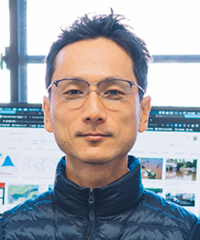
Division of Environmental Resources
Department of Environmental & Symbiotic Sciences
Faculty of Environmental & Symbiotic SciencesPrefectural University of Kumamoto
Assoc. prof.Tomohiro Komorita
My name is Tomohiro Komorita, and I work at the Faculty of Environmental Symbiosis at the Prefectural University of Kumamoto. I am pleased to have been selected for the Grants-in-Aid for Young Researchers in 2021 for the above-mentioned project. This grant will prove me with the resources to develop my research and provide me with an opportunity to receive guidance from distinguished professors, which I believe will be of utmost importance to the future development of my career. I will do my best to live up to the honor of the research grant, and I look forward to working with you in the future.
My main study topic is “How can we make a smooth material cycle in coastal areas to use biological production sustainably?” Remarkably, the Ariake Bay, my primary field of study, has one of the most extensive sandy tidal flats in Japan. We found that bivalve communities living in vast tidal flats consume all the local primary production. Although there is still high productivity of bivalve populations in the tidal flats from Ariake Bay, the catch of short-necked clams and hard clams are at a low level.
As one of the methods to recover the clam stock, sand covering of tidal flats has been promoted since around 2000. While sand is in short supply on the tidal flats, the problem is the amount of sand allowed to be deposited in the upstream dam. I would like to solve the sand mismatch problem between the dam and those tidal flats and recover the tidal flat ecosystem. To do this, I must first ask, “Where can we cover sand to effectively increase the number of the clam?” The question needs to be answered. Because of the large scale of the sand covering project, it is difficult to test the project. Therefore, I focused on a technique called mesh bags, which are nylon bags filled with gravel. This technique is inexpensive to implement and promotes the settlement of juvenile clam, that is similar in effect to sand covering. From the results of the first year’s project, it was found that covering sand in areas where clams have been settling well over the past 10 years in stock survey should be highly effective.
In last year’s mesh bag experiment, the clam density decreased only on the outside of the mesh bag and remained high on inside. This suggests that factors mitigated by the net bag, such as predation and tidal runoff, are the main causes of the clam decline. Therefore, in this year, I will establish an evaluation method for the tidal flat ecosystem, assuming that monitoring will be conducted after the sand covering. Specifically, I aim to quantify the amount of predation and runoff by using unmanned aerial vehicles to count feeding pits by stingrays, the difference in density between the inside and outside of feeding pits, and experiments to mitigate predation and export by nets.
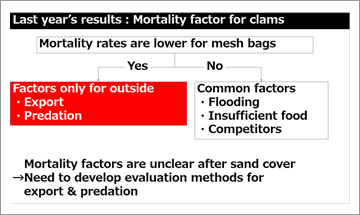
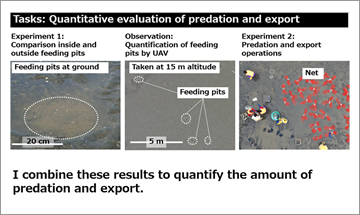
Analysis of the positive and negative effects of measures to increase nutrient loads on coastal, offshore, and adjacent seas
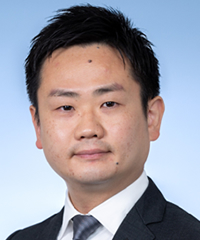
Department of Civil Engineering
Graduate School of Engineering
Osaka University
Assoc. prof.Yusuke Nakatani
I received my Ph.D. from Osaka University in March 2012, and after working at the University of Tokyo for one year, I joined the Water Engineering Laboratory of the Civil Engineering Course at Osaka University in April 2013. I am engaged in research on water environment in lakes, rivers, watersheds, and coastal areas using field surveys, numerical analysis, AI, and other methods. For more information, please visit my website (https://researchmap.jp/nakatani_civil_osaka).
In this support program, I will continue to work on the research project “Evaluation of the impact of coastal development on the water and material cycle at the regional scale in the Seto Inland Sea”. In the Seto Inland Sea, many landforms have been altered as a result of reclamation of the sea and construction of breakwaters. Although coastal development is unavoidable in the future for disaster prevention, port development, and waste disposal, it is important to manage coastal ecosystems based on a correct understanding of their impact on the water environment. The effects of geomorphological alteration on the water environment have been evaluated at the port scale, focusing on the effects on the vicinity of projects, but in fact, the effects on the bay and open sea scale have not been fully evaluated. However, in Osaka Bay, for example, it has recently been found that geomorphological alteration of the head of the bay not only locally alters the water environment at the port area scale, but also has a non-negligible effect on the residual current and water quality structure at the bay scale, as well as on the currents and material balance in the adjacent waters. In this research project, I aim to extend my study of Osaka Bay to the whole area of the Seto Inland Sea and to clarify the effects of geomorphological alteration on water and material cycles in the Seto Inland Sea by using a state-of-the-art 3-D numerical model. Last year, I constructed a high-resolution 3-D flow model for the entire Seto Inland Sea, including the open sea, and clarified how the flow, temperature and salinity structures, and water exchange between the bays have changed since the 1930s, when land reclamation was not yet underway. In the second year of the project, I will couple the flow model with a lower-order ecosystem model to analyze the effects of topographic changes on water quality and nutrient transport at the regional scale.
The numerical model constructed in this study is expected to be used to clarify the mechanisms of and examine the measures for various water environmental problems (such as red tide, hypoxia, eutrophication, oligotrophication, and COD management) that the Seto Inland Sea is currently facing. I would like to use this research as a starting point for future research on the water environment of the Seto Inland Sea, and hope to present results and knowledge that will contribute to our society.
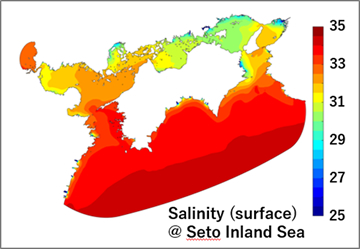
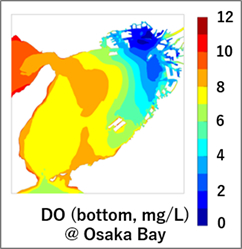
Historical changes of the supply of silica in the coastal areas and ts effects on community structure in tidal flat ecosystems(Second year)
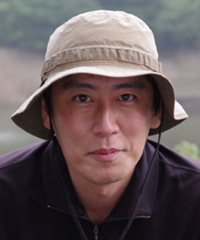
Department of Urban and Environmental Engineering
Faculty of Engineering Kyushu University
Assis. prof.Megumu Fujibayashi
I would like to offer my sincere gratitude regarding my selection for EMECS Grants-in-Aid for young researchers. This is the second time I have been selected for this program, following last year. Last year, I received very valuable advice from the advisors, and I also had the opportunity to interact with other young researchers who are also studying in coastal areas. Therefore, I am very happy to have been selected again this year and to have the opportunity to conduct research.
I am interested in the dynamics and roles of fatty acids in aquatic ecosystems. Recently, I have been particularly interested in eicosapentaenoic acid (EPA), a highly unsaturated fatty acid that is synthesized by diatoms and supplied to the ecosystem through the food chain. Since it has become apparent that supply of EPA as dietary sources may be one of the limiting factors for the animal species richness and total biomass, I am conducting research on the effects of EPA on ecosystem health in lakes and bays. In addition, since last year, I have been conducting research on the dynamics of dissolved silicon (DSi), which is an essential nutrient for EPA producing diatoms.
In the research project adopted last year, I investigated the dynamics of DSi in the Zuibaiji River, which flows through Fukuoka Prefecture. As a result, I found that a dam in the upper reaches of the river removes about 10% of DSi from the river water, and reed beds accumulated about 10 tons of silicon, which was almost equivalent to one month’s river load (Figure 1). In addition, a core sample taken from the Imazu tidal flat indicated that decrease in DSi supply to the Imazu tidal flat after the start of dam operation (Figure 2). In the second year of this research project, our goal is to quantitatively evaluate the DSi budget at the Zuibaiji River. For this calculation, I will also consider the effects of paddy fields and diatoms attached to reeds. I will also evaluate the impact of changes in DSi loading to the Imazu tidal flat on the production of benthic diatoms at the tidal flat. In the future, I hope to increase diatom production by DSi loading management, and contribute to the conservation of the ecosystems through stable supply of EPA.
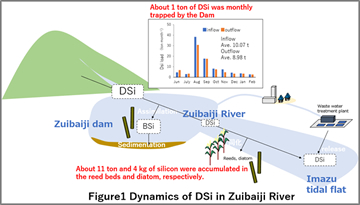
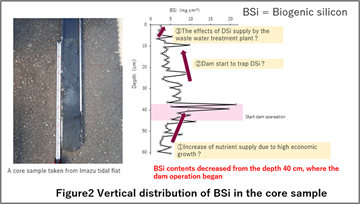
Relationships in seasonal fatty acid composition between oysters and microalgae
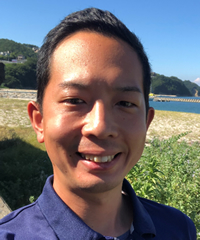
Faculty of Agriculture, Kagawa University
Doctoral ResearcherMasatoshi NAKAKUNI
I am a postdoctoral research associate at the Faculty of Agriculture, Kagawa University. The theme of this research is ” Relationships in seasonal fatty acid composition between oysters and microalgae “. Essential fatty acids such as eicosapentaenoic acid (EPA) and docosahexaenoic acid (DHA) are important for fish growth and are known to improve the growth rate of fish. In marine ecosystem, essential fatty acids are produced by microalgae, and therefore microalgae is the base of fatty acid source on the food chain. Fatty acid composition in oysters may change with microalgae fatty acid composition changing with season. However, there is limited knowledge of how the fatty acid composition of microalgae is transferred to that of oysters under in situ environments. Therefore, this study will determine from field observations how much microalgae have fatty acids and how they are passed on to oysters. Even if the amount of food is high, if the food does not contain sufficient nutrients, the organisms that eat the food are not expected to grow well. In this study, I will evaluate prey quality, which has not been well verified, and follow changes in predator nutrients in more detail by analyzing fatty acid compositions.
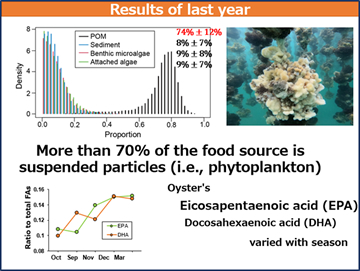

Studies on the distribution and growth characteristics of nanoplanktonic diatoms, the food for bivalve larvae, in the Seto Inland Sea, Japan
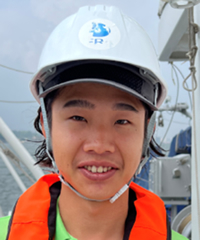
Coastal Productivity Research Group, Coastal and Inland Fisheries Ecosystems Division, Environmental Fisheries Applied Techniques Research Department,
Fisheries Technology Institute, National Research and Development Agency, Japan Fisheries Research and Education Agency
ResearcherTomohiro Okamura
I would like to appreciate to be selected for the “EMECS Grants-in-Aid for young researchers”. I belong to the Coastal Productivity Research Group, Coastal and Inland Fisheries Ecosystems Division, at the Fisheries Technology Institute, Japan Fisheries Research and Education Agency. Our research focuses on changes in primary production and related environmental factors in coastal areas.
Bivalve, a filter feeder, provides us not only food, but also clean and healthy coastal environment. However, In Seto Inland Sea, production of asari clam and other bivalves has been decreasing since the mid-1980s. Various factors have been pointed out as reasons for this decrease, and we focus on changes in the feeding environment, which lacks knowledge. In previous study, we examined the relationships between feeding environment and production of pacific oyster in the Hiroshima Bay. The result showed that the abundance of <10 μm sized diatoms (nanoplanktonic diatoms, larval food) was important effect on oyster production, suggesting that the feeding environment during the larval stage is important for bivalve production. However, in the Seto Inland Sea, knowledge of the feeding environment for bivalve larvae is lacking and it is unclear whether this sea is currently suitable for bivalve production. In this study, in order to determine and characterize the areas where food for bivalve larvae is abundant, we will investigate the distribution and biomass of nanoplanktonic diatoms, the food for bivalve larvae, in Seto Inland Sea. Our previous study also indicated that nanoplanktonic diatoms formed a bloom after a bloom of >10 μm sized diatoms (medium-sized diatoms). In addition, nanoplanktonic diatoms of the same genus detected in our previous study have been shown to utilize organic matter (Adelaide et al., 2021). Therefore, we hypnotized that nanoplanktonic diatoms grew by utilizing organic matter derived from medium-sized diatoms. We will test this hypothesis through high frequency observations in the Hiroshima Bay and laboratory experiments to reveal the bloom formation mechanism of nanoplanktonic diatoms.
The results of this study will provide insight into the environmental conditions suitable for bivalve production and also provide the basic data for analyzing the causes of decrease in bivalve production. We believe this study will contribute to the sustainable use of bivalve resources and the maintenance of a healthy environments in coastal areas around the world.
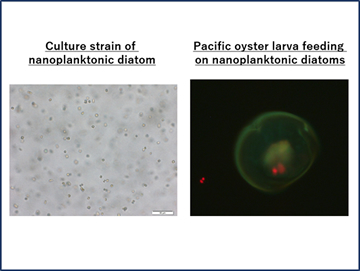
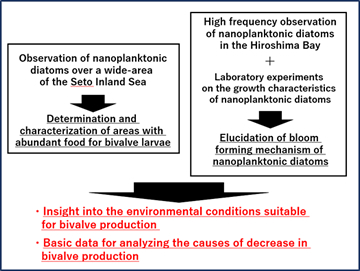
Spawning and migration ecology of anadromous Japanese grenadier anchovy in the Ariake Sea
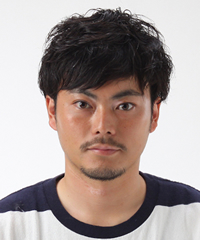
Atmosphere and Ocean Research Institute, University of Tokyo
Assis. prof.Hikaru Itakura
I’m Hikaru Itakura working at Atmosphere and Ocean Research Institute (AORI), University of Tokyo. I received my PhD from Graduate School of Frontier Science, University of Tokyo in 2014, and then worked at Graduate School of Science, Kobe University as a JSPS Research Fellow and at University of Maryland Center for Environmental Science (UMCES), Chesapeake Biological Laboratory (CBL) in USA as a JSPS Oversea Research Fellow. My research topic is understanding response mechanisms of fisheries resources to environmental change, with primary interest of how diversity in migration and life history contribute to resilience in exploited fishes under environmental change. I have been studying effects of climate change and habitat modification on distribution, migration, and growth of migratory fishes such as freshwater eels and striped bass that migrate between marine and freshwater habitats.
In this research project, I will study about spawning and migration ecology of anadromous Japanese grenadier anchovy (Coilia nasus), to contribute to the conservation for enclosed coastal seas and resources management of this species. The enclosed coastal seas including estuaries and inner bays are an important ecosystem with high production and biodiversity around globe. In particular, the estuarine turbidity maximum (ETM) formed in brackish water is essential habitats for many aquatic organisms. Fishes of genus Coilia (family Engraulidae), which are widely distributed in East Asia, strongly depend on such enclosed coastal seas, especially ETM zones, and migrate between the sea and rivers. Thus, they have a potential to be an indicator species for conservation of health of ETM zones and connectivity between rivers and enclosed coastal seas. In Japan, Japanese grenadier anchovy is distributed only in the inner part of the Ariake Sea and its inflowing rivers, such as the Chikugo River, and adult anchovies migrate upstream for spawning up to the tidal freshwater area in early summer. Owing to such limited occurrence in space and time, they are prized as a summer feature in the local area. However, the fisheries catch of the species has continuously decreased over the past decades. Despite this situation, ecological knowledge of Coilia are scarce. Therefore, I will explore locations of potential spawning rivers and nursery grounds, migration patterns, and spatial distribution in the Ariake Sea of the anchovy using otolith stable-isotopic ratio and environmental DNA analyses, in order to clarify environmental characteristics that the fish represents along their life history. In the future, I would like to examine the degree of natal homing and population dynamics of the anchovy in Ariake Sea so that the results will contribute to the conservation of enclosed coastal seas and appropriate resource management of Coilia in East Asia based on ecological information of this symbolic fish.
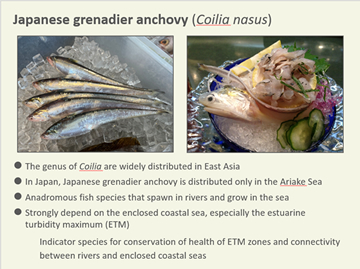
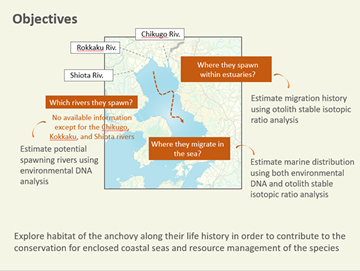
Dynamics of Transparent Exopolymer Particles (TEPs) in the eelgrass meadows of Akkeshi-ko estuary, Japan
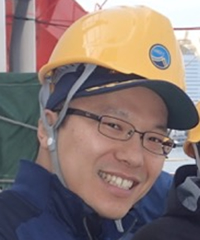
Akkeshi Marine Station
Field Science Center for Northern Biosphere
Hokkaido University
Assoc. Prof.Tomonori Isada
Firstly, I am deeply grateful to International EMECS Center for itsGrants-in-Aid for young researchers to me. I am studying marine phytoplankton and seagrass dynamics in Akkeshi-ko estuary and Akkeshi Bay, which arelocated in the eastern part of Hokkaido, Japan, to better understand the carbon cycle in the coastal marine ecosystem.The northern part of the subarctic enclosed coastal sea of Akkeshi-ko estuary is connected to the mouth of the Bekanbeushi River. The riverruns through the Bekanbeushi wetland, the second largest wetland in Japan.These regions are designated as a Ramsar wetland sites and a Quasi-National Park of Japan. The southwestern part of Akkeshi-ko estuary is connected to Akkeshi Bay, which is affected by the cold Oyashio Current.Akkeshi-ko estuary is covered with eelgrass (Zostera marina) meadows. Additionally, the mariculture of Manila clams and Pacific oysters is currently prospering in Akkeshi-ko estuary.
Macroalgae beds and seagrass meadows in estuarine and shallow coastal areas have a significant role incarbon burial and sequestration to mitigate climate change as blue carbon. Especially, Japan is considered to be a major blue carbon area because Japan has the sixth longest coastline in the world. It is therefore important to understand the carbon cycle of macroalgae beds and seagrass meadows in estuarine and shallow coastal areas.
In this project, we focus on the Transparent Exopolymer Particles (TEPs)dynamics in eelgrass meadows in Akkeshi-ko estuary.TEPs consist of acid polysaccharides and are sticky particles with > 0.4 µm diameter, resulting in particle aggregation like marine snow. TEPs significantly contribute to the carbon flux into deep waters. TEPs stem from dissolved organic matter (DOC) released by aquatic organisms. Many previous studies showed that phytoplankton is the main producer of DOC and TEPs in coastal and open oceans. However, little is known about the concentration of TEPs and their controlling factors in seagrass meadows.Since seagrass produces a large amount of DOC, TEP also could be producedin the seagrass meadows.Although the root and leaf litter of seagrass are themain fraction of carbon burial and sequestration, the evaluation of carbon storage by TEPs in the seagrass meadows is required.We aim to investigate the spatio-temporal changes in TEPs concentration and clarify the factor regulating TEPsin the eelgrass meadows of Akkeshi-ko estuaryfor environmental conservation and sustainable management of aquaculture and fisheries.
